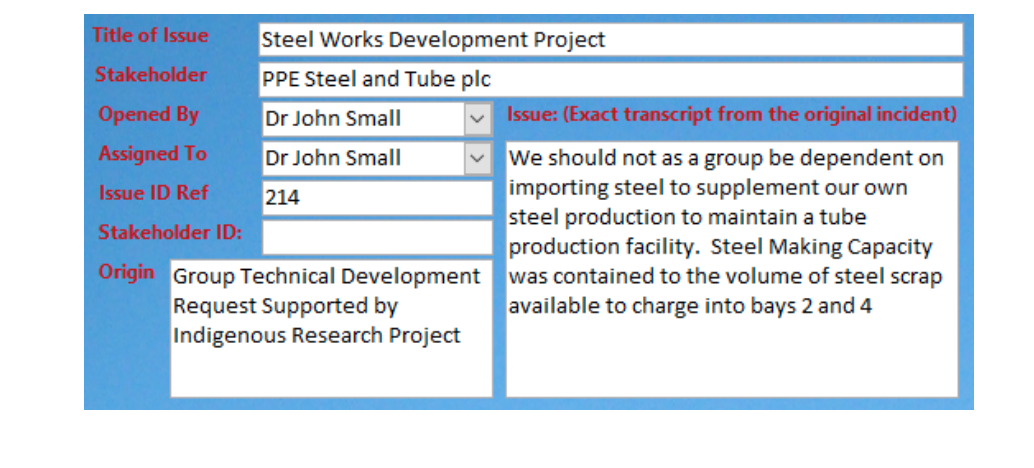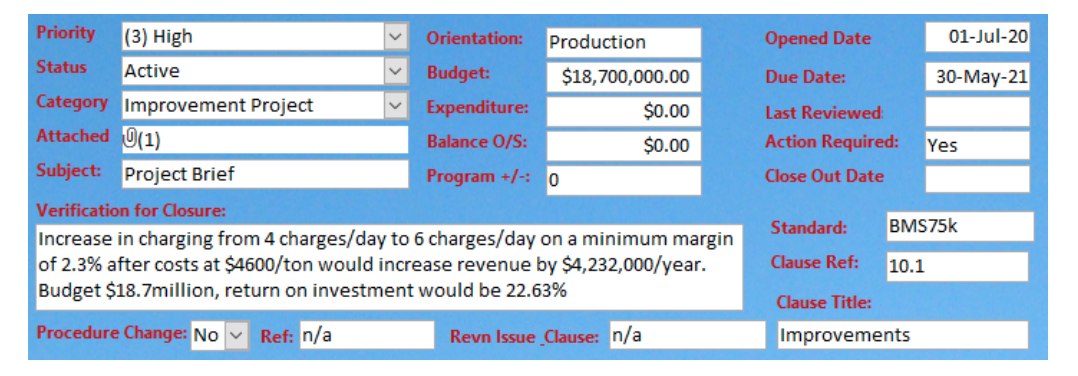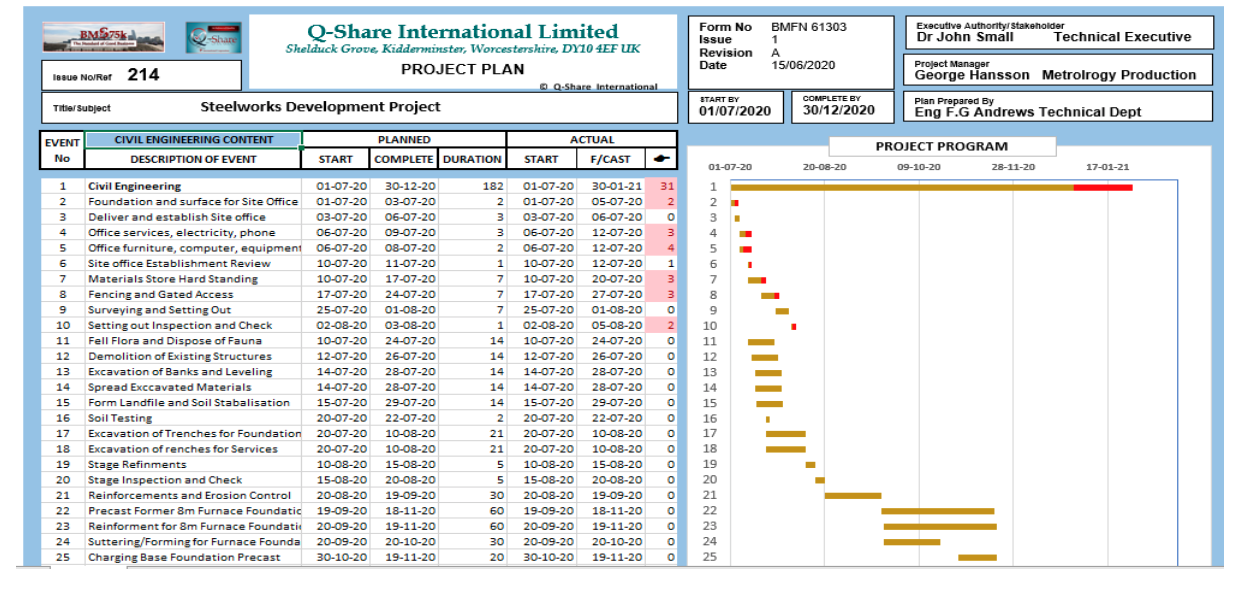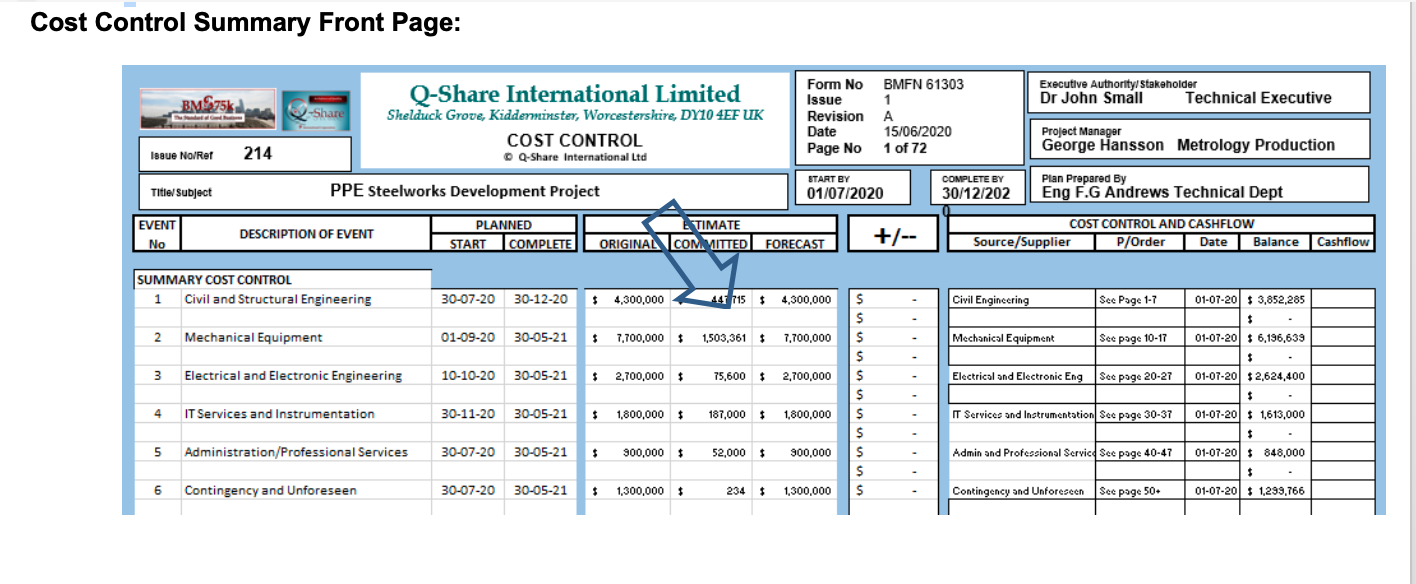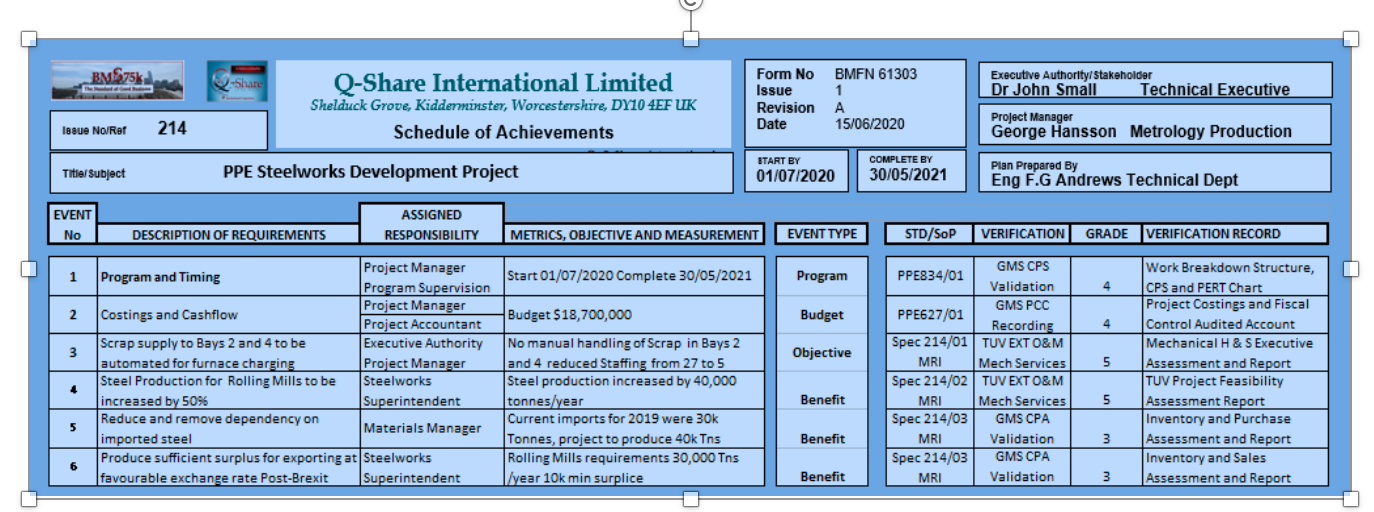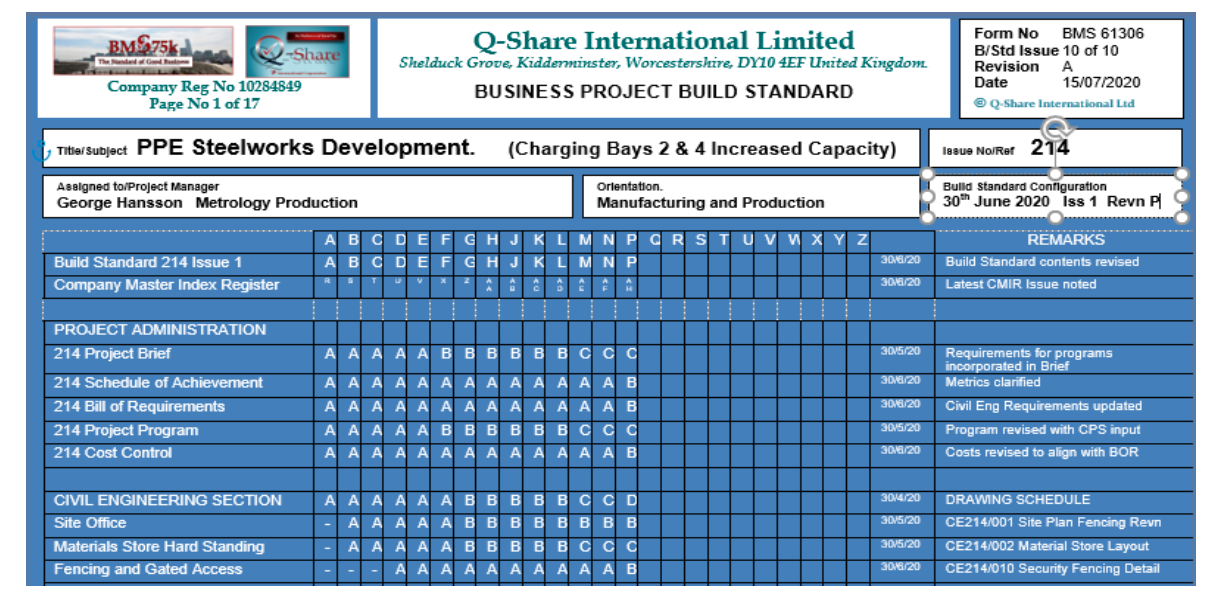 The Business Management Standard BMS75000:2020 promotes the 5As convention in the disciplines required for sound Business Management. In writing the procedure (BMAP01/001) to cover the practical application for the 5As convention to solve a Business Management Issue, it became apparent that two main types of business issue require a solution as well as a system to process.
The Business Management Standard BMS75000:2020 promotes the 5As convention in the disciplines required for sound Business Management. In writing the procedure (BMAP01/001) to cover the practical application for the 5As convention to solve a Business Management Issue, it became apparent that two main types of business issue require a solution as well as a system to process.
- All business issues that are rated as low risk, are deemed to be inherent in the business process and for which provision is already made in the margins and contingencies we protect and maintain.
- All business issues that are not low risk can foreseeably influence the strategic interests of the business and as such must be assessed as an issue in the business management program, and suitably addressed as requiring additional resources to contain or resolve.
Each company will have in place their risk analysis procedures and metrics to be guided by and elect to accommodate or project manage an identified New Business Issue. But let us first reacquaint ourselves with the 5As Convention:
Anticipate The identification of risks, opportunities, trends, and life cycle stages.
Assess The determination of quantified and measurable aspects or attributes.
Accommodate The hosting and processing of resources needed to accept.
Analyse The measurement of the product of the Business Activities
Account The recording and stewardship of the work done.
The convention connects all the requirements in a straight line but directs us to associate Anticipate with Account and Assess with Analysis. This requires a detailed explanation to fully understand the 5As and to allow us to apply the convention correctly if we are to derive the maximum benefit from its culture and merits when used for a project managed solution.
In developing an explanation of the 5As conventions characteristics and attributes, we must first consider the context in which we identify problems or opportunities and the process by which we find the correct or most suitable solution. Having exercised the anticipation practices to identify a potential issue, be it risk or opportunity, we must then consider if the issues relevant to the company would directly interfere with the currently planned arrangements and if so by how much.
The decision to assign an issue to the business program must be correctly informed and the authority responsible in the circumstances of the occasion must be recorded. This is required so that the event can be simulated at a later stage which may be required to support the decision as being informed and correct. Once the issue is sentenced as relative, and significant, it needs to be included in the Business Program and the issues database or other form of record is needed to complete its initial detail as the first stage of the Business Project Cycle.
1 Anticipate:
By introducing the activity to “Anticipate” into our management process we help the company to thrive and benefit in situations we do not have control over. Because we can not anticipate the unforeseeable, perceive the unexplainable, and plan for something unbelievable, we must and can, test the resilience of our company capacity and resources, to see at what point it would fail and put in place the triggers to instigate preventive action.
In seeking to anticipate issues that need to be accommodated and managed, we must incorporate the possibility of the unforeseeable or undefinable that does not necessarily stand up to a definition or quantified analysis. The consequence of such an issue can, however, be quantified, and as such its measurement and consequence can be determined, together with the company’s ability to accommodate and adapt a solution.
Effectively in such issues we must be continually asking and assessing, when would the company fail and at what stage would contingency provision in our resources and reserves be exhausted. At each stage in the problem-solving process, we must test the available options by:
Anticipate we are going to get it wrong Consequences Are?
Anticipate we are going to get it right What will we Achieve?
Unforeseen external issues can only be deemed to require action when the issue impacts significantly and directly on the planned arrangements and strategic intentions of the company.
Although there are several methodologies to provide a selection of subjects for the company to consider when anticipating issues, the PESTEL analysis is recommended. This model is an external factor evaluation matrix that focuses on six spheres of data:
Political: Action by a government that can influence the taxation or economy to which the company, market, or sector will be affected including the government policy, political stability, and trade.
Economic: Economic condition which directs the company’s competitive and comparative advantage including economic policy, tariffs, growth, inflation, full employment, the balance of trade, and interest rates.
Social: Social-cultural and conventions which illustrate customer needs, expectations, and ambitions. This includes emerging trends, fashion, religions and population analytics, and demographics.
Technological: Research and development influence a market or sector including technology, automation, know-how, new products, skills, process, management methods, communication practices, competition, and products.
Environmental: Ecological and environmental issues that can involve a company’s operations or consumer demand, access to renewable resources, weather or climate changes, and our Corporate Governance.
Legal: Statutory and legislative instruments within countries, territories, and boundaries in which we operate including health and safety requirements, trade union and labour laws, consumer protection, and trading
2.0 Assess
This second phase, in our 5As business convention, is “assess” which is the quantitative activity, required to determine if an issue should be managed as a project or assigned to the standard existing business resources and process. Before we can record and quantify the issue it needs identity and definition for which the following questions must be answered:
What: What is the issue, its description, its orientation, its characteristics and how can it be best described and identified?
Why: Why is this an issue for us, why should we be concerned or involved,
why is this an issue now and not previously, why was it ignored?
Where: Where does the issue originate from, its source, where does it reside, where are the business activities that are inconvenienced, or can be improved?
When: When will the issue materialize, is timing involved, is it dependent on the performance of other related issues being resolved, what are the stages involved, is it phased into a trigger, an activity, or is it graduated?
Who: Who does the issue involve, their interests, their responsibilities, their vocations, who are the drivers, who will the outcome effect, and most importantly, who will be given ownership for resolving this issue?
Note: The Make or Buy Decision should also be considered here.
It is important when “assessing” an issue to determine if it could impede or improve the integrity and achievements of the Strategic Business Plan or Business Program. This phase, in our business process, assesses an identified issue and there is a direction to be agreed whether to include an issue’s project into the business program or to conclude that our standard existing monitoring process can deal with it.
The standard practices for risk assessments serve us well in this respect as the discovery of an issue that would affect the integrity or achievement of planned events is to be treated as a detriment to the planned results of the company, and as such can impact on the performance and the integrity of the Strategic Business Plan.
Also, we need to accommodate the opportunities which arise because of our research, awareness, and analysis practices, identifying a situation or course of action that would provide the company with a favourable result.
The issues database or its equivalent is the vehicle which hosts and manages the issue record and its details can be recorded as follows
We next need to establish, implement, and maintain a record of the issue to assess any foreseeable business detriment associated with the strategic interests and assure the required integrity and achievements of the Business Plan. An assessment will need to be made and converted into the issue record like this one:
Provision must also exist for date and event records to assist in marshalling and progressing the solution.
There should be a relationship with the BMS75000 standard, and specific clause numbers which can be used for analysis and reporting. Once the record has been compiled, an assessment of the issue and its implications can commence.
When an assessment concludes our standard provisions, resource, and contingency to be inadequate, then the issue should be given a project status and allocated to the business program.
Note: It should be noted that both the relevance and the occasion can change at a
later stage due to unforeseen events.
The commitment of an issue to the business program is determined, at the appropriate level of management. This business decision must include consideration of the following:
- Identification of the issue, including known or foreseeable causes and
consequences, taken from our assessment knowledge. - Identification of the triggers and the means of early warning (detection)
to permit containment at minimal cost and disruption. - Identification of the occasion and related processes that will benefit or
are exposed to detrimental risks.
The assessment of issues consequence and anticipation of the benefits or detriments must then be considered including:
- The severity of the detriment, or the magnitude of the benefit.
- Likelihood of the detriment or benefit to the company.
- Risks compounding, or benefit contributing to other activities.
We must seek to have an informed and defendable position for the decision to project an issue or to simply adopt it into the standard process. This will depend on the magnitude of the issue’s detriment or the magnitude of the issues benefit, to the Company Business Interest.
Only when a Defendable and Informed Position from Indisputable Valid Information can be confirmed, should we proceed to the 3rd stage of accommodation.
3.0 ACCOMMODATE
The 3rd phase of 5As is “accommodation”, which is the project management stage of doing the work. Having identified an issue that requires additional resources or time, we must manage it, and ensure the solution is implemented and the required result is achieved and validated.
Each Executive Authority needs to become conversant with the new and current issues and prepare recommendations for subsequent consideration, approval, and authorisation at the appropriate level.
The issues identification, analysis, and assessment commence with acknowledging the relevance of an unforeseen event and provision for addressing its implications are provided for, within the business program. The review of relative unforeseeable issues will include:
- Adequacy of current risk and other relative subjects’ insurance cover,
- Supply chain and logistical operations concerns,
- Finance liquidity, banking strategy and access to domestic currency,
- Tailoring the nature of the business to the nature of the risk, and specifics of the market.
- Regular advice and consultation from informed authorities,
In accommodating an issue, we must decide if the current arrangements are adequate and robust enough to accommodate the issue without additional resources or change to existing planned objectives.
If not, we must raise an issue and incorporate its requirements for control, into the Business Program.
The business program must be regularly assessed and tested to ensure all issues are suitably reviewed and resourced. Priorities will change as the importance of each given issue changes and become relative to the Company Business objectives.
Accommodation is defined as “to do something that someone else asks of you, or wants from you”, and in our case, the Business Management System is asking the company to comply by accommodating a known requirement or, to identify any unknown requirements which need consideration and placement in the Business Program.
Once we have identified the issues orientation we can then determine, who has the authority and know-how to make the decisions and alert the authority concerned as to the issue and its consequences or benefits so an informed defendable decision can be reached.
Correct consideration to completing the issue record in the issues database provides us with the disciplines needed to establish the record and register its progress and completion correctly.
The orientation of the issue and its project will be self-evident, marketing, sales, design, supply, process, verification, financial, or perception. Also, the nominated Executive Authority can enlist the services of Technical Departments to prepare the Project Brief as a development project.
The planning of any project requires blocking in stages and the resolving of a Business Issue is no exception. Each of the issues authorized for listing in the business program will contain at least one measurable objective which will incorporate as a minimum:
- Reason and Purpose: The reason why the project is necessary is the subject of the Project Brief which is produced from the assessment of the anticipated issue. This is the authority from the executive to allocate the required resources to the project and contains data to set up the issue database records.
- Business Case: The preparation for a business case justifying the investment in resource, time, and manpower. Budgets Plan Cashflow, funding sources, and stipulations are included.
- Defining Inputs: Overview of requirements and resources, including information sources, special skills and know-how, IT programs and hardware, available PPE, and
- Statement of Work: This is a list of tasks and their sequence in which the project work is planned.
- Bill of Requirements: A definitive list of the requirements of the project including finance and cashflow provisions.
- Defining Tasks: Report establishing milestones, identifying activities, processes, practices, and their sequence with Hold Points for measurements, reporting, verification, and reviews.
- Defining Outputs: Specifying the Project deliverables, including stage and final objectives, completion criteria, and the case for closure.
- Managing Progress: Instigating and managing progress against plan, controlling the agreed estimated budget.
- Steering: Instigating the commencement, processing, and completion of each stage as they are realized.
- Involved Parties: Directives for maintaining communications with participants, stakeholders, and interested parties.
- Completion Prep: Schedule of Achievements for results, tested measurements, impact records, compounded and related issues, and any further work to do.
- Completion: Verification and validation of closure and completion recorded in a
Schedule of Achievements.
For large complex projects, a steering Committee and Program Management Group can also be appointed to control events and sequence.
Project Plan
The project plan is the time-based mapping of the sequence of the project activities. This results in a sequenced task plan required to establish milestones, identify activities, processes, practices, and their sequence with Hold Points for measurements, reporting, verification, and reviews.
The Project Manager shall decide the methodology and format which best serves the purpose alternatively directives may be provided in the Project Brief when reporting is stipulated by the Group Executives.
Regular monitoring and reporting of project expenditure must be completed by the Project Manager who is assigned authority to review and commit purchases against the budgets agreed provided they are within the sums agreed. To assist in this task the project Cost Control is used to record and report the financial progress and management of the project.
The front or header page summarizes expenditure against the main categories of the project. These summary figures are uploaded from the detailed sections of the controls as shown below:
The Cost Controls verify expenditure against the allocated agreed budgets and identify changing patterns or circumstances that need accommodating with corrective action. Each assigned authority applies this documented cost control practice which defines the responsibilities and requirements for planning and conducting budget reviews, establishing records, and reporting results.
The reviews control expenditure by monitoring progress against each of the budget items at planned intervals. Also, appropriate reporting and authorization mechanisms are exercised by the Group Board down to Department level control expenditure within the projects.
Bill of Requirements
The Bill of Requirements is a definitive list of the requirements of the project including finance and cashflow provisions divided into 5 sections:
- Personnel, Skills, manpower, know-how, consultants, advisors, management services, and in house services,
- Plant, Equipment, in-house processes capacity, test/inspection facilities, transport, computer hardware, comparators, and gold standards.
- Materials, Components, consumables, and utilities
- Information, Data, techniques, technology, IT facilities, Special techniques
- Locations offices, accommodation, test sites, logistics and storage
Where the project is proceeding at risk, provision must be made for contingencies and unforeseen to be added to the bill of materials as the project proceeds.
4.0 Analyse
The analysis phase in the 5As convention when applied to a business issue project, consists of testing two aspects of the issue:
- Adequacy of the prescriptions against which to measure and complete the tasks,
(Issue Brief, Schedule of Achievements and Terms of Reference) - Results of Measurement, confirmation of the issues progress, and the results of the Business Activities to validate completion.
The analysis of a given issue must revisit and record the completion of each stage in the project’s program to confirm if the objectives were suitably defined as well as, realized and that the task was completed correctly against clearly defined criteria given the circumstance and the occasion in which decisions were being made.
Reason and Purpose
The reason why a project was necessary, needs to be tested against details provided in the project brief which is produced from the assessment of the anticipated issue. The executive authority decision to allocate resources will be based on information that must be checked and verified to compare with the achievement.
Business Case.
We must revisit the Business Case for justification of the investment made and check that the case was correctly and fully screened and assessed for inclusion in the business program.
Analyzing Inputs
When analyzing the inputs to the project, the Bill of Requirements can be used to determine if resources were correctly identified, quantified, and assigned. This can be checked from the detail contained in the 5 sections of the Bill of Requirements personnel, plant, materials, and premises should be fully specified so they can be acquired, managed, and allocated. This can be verified from associated records and reports on the items listed.
The issue/project brief includes the producibility and testability of each option in the evaluation of each solution that is suitable, designable, producible, and measurable to address the issues needs that have been identified. Consideration must also be given to testing each of the attributes, advantages, and disadvantages of each option identified as a posable solution to verify the reasoning for the option selected.
The Project Manager should seek to balance general requirements with specific requirements in this evaluation. This evaluation will require validating the chosen issues solution, its concepts, and merits by checking the following matters received the correct amount of consideration:
- Intellectual property considerations, (Such as parents, infringements, jurisdiction or sovereignty)
- Statutory and legislative requirements (Local, domicile, and global)
- Reimbursement (Sources of funding and recovery of development costs)
- Business Models (Solution characteristics in each available model)
- Prototyping (Identify the Questions or Issues to be Addressed)
The additional information gathered through the considerations listed above must be reviewed to ensure that each aspect of the solution as well as other steps in the project briefing process have been addressed including those that were instrumental in the decisions required to proceed, suspend, or complete.
Analyzing Tasks
When defining and analyzing the tasks of the project, there are two distinct requirements:
- Ensuring there are clear and precise details for each of the tasks involved, with hold-points established, and criteria for commencing and completion of each task.
- Analysis of the results and achievements of each task, for the comparison between specified and actual results.
The issue project must identify the business processes and sequence of tasks with which to manage the operational activities stated in the project brief. The requirements for each task shall include those needed for:
- (Inputs) Commencing the task
- (Practices) Activities involved in the task
- (Outputs) Product of the task and
- (Means) To measure the task timeliness, quantity, and quality at each stage in its sequence.
Tasks normally have one single product but may depend on numerous inputs and contain several activities in sequences that must follow a defined route. Such multi-dependent activities when documented are referred to as a Project Process Plan and are greatly assisted using Critical Path Scheduling.
Any prescriptions or preferences specified by the assessment, and accommodation stages must be incorporated. The process involved in defining and analyzing tasks would require:
- Establishing the milestones,
- Identifying individual activities,
- Incorporating proven processes, and practices,
- Determining the required sequence and priorities,
- Establishing Hold Points for measurements, reporting, verification, and reviews.
- Verifications for 2nd party and 3rd party assessments and tests.
Information and inputs to each task in the issue project must be specified, and the business activity assessed and verified for correctness upon completion before proceeding.
The Statement of Work in the Project Issue Brief and the Bill of Requirements has a major contribution to the Quality of the Project and its associated tasks.
The publications analysis of these, as both inputs and outputs to the project, must be recognised and their contents analysed as a principle consideration in task analysis.
Note1: It is essential that the milestones and hold points are introduced at stages that
would be difficult or costly to proceed past without assurance that the work
done to date is correct. Failure to do so would create a situation where costs
and resources were being deployed on a potentially failed project that could not
be corrected or used.
Note2: Identifying individual activities in a business issue can require more than one
activity requiring completion to create a single result.
Note3: Incorporating proven processes, and practices will greatly strengthen the
project, but only if the provenance of the practice is also included in the data
retained under the “Account Phase” of the issue.
Analysing Outputs and Deliverables
When defining and validating the Output and Deliverables, we must consider:
- Content and adequacy of the project brief, the clarity of its objectives, and specified requirements for completion. (Defining)
- Complete and total compliance of each stage (Verifying) and the completion against the qualifications for closure or release. (Validating)
The brief must be checked against known results, to ensure it specified the issues deliverables. Defining the outputs in the Project Brief serves the following requirements:
- Allows for development, production, and/or acquisition.
- Alignment with all known functional, technical, and operational requirements.
- Establishes realistic stakeholder expectations.
- Obtains consent and acceptance.
- Measurement criteria for result testing and review.
As such there are two distinct types of project output deliverables namely:
- Project Deliverables, Completion at the end of the project.
- Process Deliverables Reported and verified during the project’s progress.
In respect of the project deliverable outputs the project brief should have specified:
- Problem resolution: Why was the issue raised, purpose, and occasion?
- Prime Objective Output: What is the specified purpose of the project?
- Reporting authorities: Who is required to be informed of completion?
- Location and logistics Where is the completion to be demonstrated or reported?
- Timescales and program When is the deadline for completion?
- Methodology and process How is the issue to be processed and resolved
In analysing and verifying the above requirements with the results of the project, the following must be recorded and reported when applicable:
- Details of problems the project must encounter and solve.
- The processes and their application used to prove the methods employed
- Constraints and disciplines imposed and adopted.
- Timing (Start-Finish) applied to each stage in the project both planned and actual
- Make or buy analysis
- Specified reporting authority to take instruction from
- Formats and programs used to report with.
- Responsibility for planning, progress, and implementation
- Authorities to accept and approve the results reported
- How each deliverable requirement was updated or maintained?
- What was the nature, form, fit, and function of the output?
- In what form delivery was made? (Report, result, product, event, sample or process)
- Cost-control and funding feasible (Was there a staged release of funding?)
- Alternative fallbacks provision (What if?)
- Result validation authority.
- Who was ultimately responsible for the output?
If there is insufficient information available at the point of authorizing and commencing an issue to address all these subjects, it should be noted, and the issue and its project endorsed accordingly as “Proceeding with Risks”.
Managing Progress Analysis
At each stage in the project’s progress, it should be known, what has been completed, what needs to be completed, and when it will be completed.
The commencing and completion of each stage and task must be monitored and recorded against the project plan derived from the project brief.
Instigating and managing progress against the plan is an important and recognised responsibility of the Project Manager. Managing progress for the project also requires:
- Controlling the agreed estimated budget.
- Ensuring work done is within the scope of the requirements of the issue,
- The Rational and identified needs are communicated to task owners,
- Specified constraints and considerations are observed,
- Project program and time scales are maintained,
The Project Manager will also be assigned the custody of the Project Brief and will be tasked with collecting the information and completing the brief so there are sufficient detail and instruction to commence each stage. This is because it is imperative that the brief accumulates and hosts the ongoing details of the issue and solution, for final review and validation of all decisions made and by who.
Steering Analysis
The activity of steering a project and resolving the issue involves instigating the commencement, processing, and completion of each stage as they are realised.
This activity is a management of tasks and has already been covered significantly in this publication, however, the following diagram will assist in understanding the requirement of steering a project: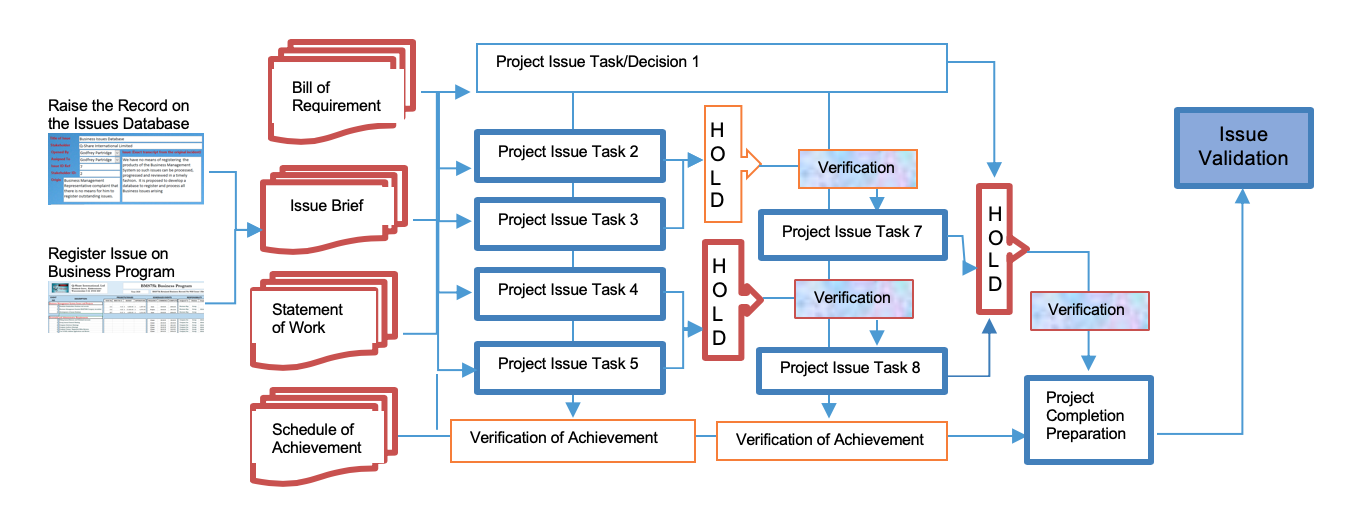
When steering the project, it should be observed that non-dependent tasks (1) can proceed concurrently, however dependent tasks (2-8) must proceed in the prescribed sequence which best serves the final objective and the specifics of the project.
Analysis of Involved Parties
Maintaining communications with the project participants, stakeholders, and interested parties are the duty and responsibility of the Project Manager. The Issues Database and Brief will identify the parties who have an initial interest in resolving the issue and assisting progress.
The project will accumulate more parties with interests as it progresses, and its competition can depend on the cooperation and support of other parties affected by the issue. Here the Company Policy for Addressing the Needs and Expectation of Interested Parties, is important in determining who is considered to have an interest in a given issue, determine the relevance and extent of the interest these parties are credited with. We must develop the ability, competence, and capacity required to achieve the requirements and expectations of the identified parties. In implementing the policy on interested parties’ needs and expectations, a documented procedure should be applied which involves:
- Identification and Registration of Interested Parties
- Determining Interested Party Interests, Contributions, and Concerns
- Addressing the Needs and Aspirations of Interested Parties and,
- Communication with Internal and External Authorities and Parties
Frequency and subjects of communication should be determined early in the project’s progress and maintained.
Analysis of Completion Preparation.
Only when an analysis of the preparation for completion has verified that there is no additional or outstanding work to complete, can the issue be validated. The tasks completed and decisions made during the progress and occasions of the project will have completed stages and requirements of the project/issue brief, but it will also generate additional requirements.
Here a Schedule of Achievements within the Statement of Work will be addressed with completed results, measurements, and impact records, which, when analysed, will become compounded and subsequent related tasks will identify if and when further work needs to be done.
An understanding of completion terms and conditions should be established early in the project if not already catered for within the project brief. These then convert to a “Tick List” for subsequent assessment and analysis which can double up as the “Schedule of Achievements”.
Note1: In projects for issues of acquisition, it will invariably require conditions to be established that require satisfying to demonstrate completion.
Note2: Accounts of the target company drawn up at or shortly after completion of the acquisition form the basis for determining the final amount of consideration payable under the share or asset purchase agreement.
The issue and its project have been synonyms up to this point, as the issue contains the objectives for the project to complete. At this stage, the project and issue will need to be separated in order for the projects constituent parts and components to be assessed as complete and satisfactory.
Only when this has been achieved can consideration be given to the issue’s validation. To provide for due diligence over the issue’s management and decisions, we must minimize any disagreements with the objectives and outcome of the project among stakeholders.
This should be done by having a Schedule of Achievements acting as a prescription for events to be verified. This is normally incorporated in the Statement of Work for each issue brief in which the projects achievements can be reviewed, measured, tested, reported, and subsequently verified.
Each schedule of achievements would be “Issue Specific” when listing the deliverables due to the objectives, occasion, programing and technology of the issue and project, however the following format could be applied:
Analysing Completion
To provide for due diligence over the issue’s management and decisions, we must minimise any disagreements with the objectives and outcome of the project. Each issue brief will have SMART objectives:
- Specific (suitable simple, sensible, significant).
- Measurable (meaningful, motivating).
- Achievable (agreed, attainable).
- Relevant (reasonable, realistic, and resourced, results-based).
- Time-Based (timely, time-limited, time/cost limited, time-sensitive).
Verification and validation of closure and completion are greatly assisted by having developed a comprehensive and complete Schedule of Achievements. Also, it is advised to check and verify the following before the project is offered for validation:
- Are the objectives seen from an informed viewpoint SMART or are there questions to be raised as to their relevance and relationship with the Business Case?
- Was the funding adequate and has the project completed within budget?
- Can due diligence be confirmed for the decision to invest in the project?
- What are the strengths and weaknesses inherent in the project and have they all been they correctly accommodated and managed?
- Was the integration of the project within the Business Program correctly prioritized or were there more important projects or issues sacrificed to proceed with this one?
- Is the Business case verifiable?
- Was the Project Program, Task Instructions, and Sequence Planning published in a timely fashion?
- Has the Bill of Requirements, been regularly updated to record the need for all materials and personnel used on the project?
- Can we claim and demonstrate Stakeholder recognition and contributions?
- Are the Communications and records available for reporting correct and verified?
If not, then there is additional work to do and the issue can not be suitably validated.
The Project Build Standard should have sufficient details to ensure that where more than one version of documented information or record is in use, each version is recorded and its component content and deployment configuration is known and traceable to all relevant documents and records.
In addition to assessing individual business issues, it is also done for aggregate analysis to identify which category of business issues is done well, what lessons can be learned, and which business issues need repair or attention.
There are specified requirements within the Business Management Standard BMS75000:2020 that require reviews and analysis to be listed permanently in the Business Program. They are:
4.2.2 Review of Legal and Statutory Instruments
4.5 Review of External Business Considerations
5.5 Review of Cultural Issues and Conventions
6.1.4 Review of the Business Program
6.1.4 Continuous Business Improvement Programs and Register Review
6.2.3 Review of the analysis of Business Plans and Activities
6.2.7.1 Financial Plan and Budgets Review
6.2.7.2 Financial Plan and Cost Control Review
6.4.2 External Change Preparation and Management Review
6.4.3 Review of Unforeseen Issues
7.1.6 Human Resource and Welfare Review
7.6 Resources and Support for External Influences Review
8.1.1 Review of Financial Administration and Accounts
8.1.2 Marketing and Public Relations Review
8.1.3 Customer Services and Support Review
8.1.4 Technical Services and Support Review
8.1.5 Goods and Service Management and Distribution Review
8.1.6 Process Management and Stewardship Review
8.1.7 Servicing and After Sales Administration Review
8.6.1.1 Review of Process Safety and Environmental Impacts
8.8.2 Assessment of Monitoring External Business Operational Influence
9.0 Business Performance Evaluation
9.1 Monitoring, Measurement, Analysis and Evaluation Review
9.2 Internal Audit Plan and Schedule Review
9.2.3 Review of Registering the Internal Audit Results and Products
9.3 Management Review Meeting
9.4 Management of Unforeseeable Events Review
10.0 Business Improvements Review
10.2 Business Program Deviations Review
10.2.2 Root Cause Analysis Review and Assessments
10.3 Continual Improvement Review
Whilst these subjects may not have direct input to the project or be apparent as to the relevance they have, it must be recognized that these subjects make a major contribution to the Company Master Records Index (CMRI) and as such will be acknowledged within the projects own build standard of documentation and records.
A standard company practice on documented information should cover arrangements for the maintenance of the Master Index Register which is a master configuration of all MRIs in use.
5.0 Account
The Business Management Standard refers to the “Account Stage” as the recording and stewardship of the work done. This is achieved by ensuring the project produces a Defendable and Informed Position from Indisputable Valid Information.
There is no company standard size for the business issues and its project, as these are infinitely variable in content and complexity, ranging from a single solitary multi-million item of acquisition to a low-cost multi-task cross-functional development and mission.
As such the quantity of documentation and data a project will generate is also initially undeterminable, so we have developed a means of controlling and identifying records and data to the project and subject to hand.
This is achieved by using a Project Build Standard to manage and control the configuration of data produced. This should be the subject of a documented procedure covering document and data control for which a standard build standard document and register is prescribed:
Substantial work would have been completed on the previous 4 stages of the 5As during “Anticipate, Assess, Accommodate and Analysis” however here, within the final Accounting Stage, we need to concentrate on the “Indisputable Valid Information” aspect to complete the project and confirm the validated result and official records.
From project conception through to completion, it is imperative, for the integrity of the project, that decisions can be traced to the standard of information which was available for the event and on the occasion in question.
All input to the project must contribute to a complete and comprehensive record whose configuration is controlled by the Project Manager and the source of information used is registered and recorded.
The Project Manager will be tasked with maintaining a Build Standard of project documents, programs, and information that will register the date, issue, and revision of all business records for the project.
The Company Master Records Index (CMRI) must also be acknowledged in the project build standard and its date, issue, and revision noted in the project Build Standards documentation. This fixes the project documents and data to the standard of the companies Business Management System.
The record and account of the issues progress, verification and validation is worthy of an additional article as this article on the 5As subject will have undoubtably tasked the readers to a significant degree.
In detailing the records needed to validate and close the business issue consideration should also be given to:
- Records of problems the project solved and with what results.
- Application of SOPs and what was used to prove the new methods employed
- Register of constraints and disciplines imposed and adopted.
- Actual Start and Finish realized at each stage in the project.
- Make or buy analysis and conclusions
- Matters referred to the specified reporting authorities.
- Approval of formats and programs used to report with.
- Authorised responsibility for planning, progress, and implementation
- Nomination of authorities to accept and approve the results reported
- Records of each deliverable requirement update.
- Conformance to form, fit, and function of the output.
- Approval of the projects delivery format (Report, result, product, event, sample or process)
- Cost-control and funding feasible (Was there a staged release of funding?)
- Records of alternative fallbacks provision (What if?)
- Approval of result validation authority.
- Recognition of who was the ultimate responsible person and position for the output.
- Records of where and when the issue and its project Proceeded with Risks
Note 1 BMS76000 gives an account of how to grade verification activities and results in clause 0.6.2.
Note 2 A copy of the 5As Business Issue Application Documented Procedure is available to download from the Q-Share International web site www.q-share.co
Note 3 The Business Management Standard BMS75000:2020 can also be downloadeD at cost of $49.50 from the web site.
As always, we welcome good observations and constructive criticism on this article.
Please visit the discussion group dedicated to this objective. https://www.linkedin.com/groups/8909418/
Thank you for visiting.
Godfrey Partridge
CEO and President. Q-Share International Limited
Bio:
Godfrey Partridge
Q-Share International Limited CEO and President. Now stationed in the United Kingdom tasked with the administration and promotion of the Q-Share Group from an international prospective with operations now in the UK and USA directed at promoting improvements in Business Management through the use of Quality Assurance and the Quality of Compliance.
Contact information:
828 774 0763 (Work)
qshare.qa@gmail.com

